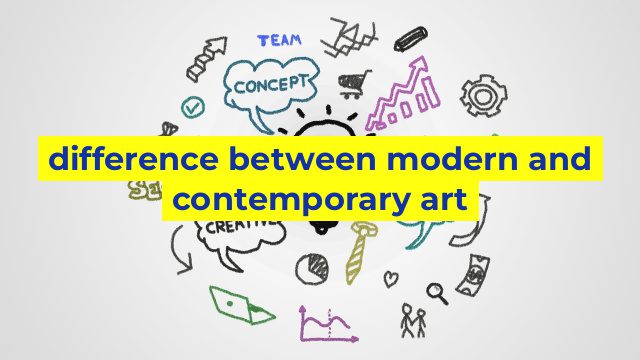The Distinction Between Modern and Contemporary Art Explained
When discussing art, the terms “modern” and “contemporary” are often used interchangeably. However, they have different meanings and identifying the difference is important. In this article, we will explore the distinction between modern and contemporary art.
What is Modern Art?
Modern art refers to the artistic movement that began in the late 19th century and continued through to the 1960s. This period marked a departure from traditional art styles and an exploration of new forms, materials, and techniques. Artists broke with conventional representational styles and created artworks that evoked emotion and reflected the political and social issues of the time.
Some of the most popular modern artists include Henri Matisse, Pablo Picasso, and Vincent van Gogh. Modern art movements such as Expressionism, Cubism, and Surrealism were also born during this time.
What is Contemporary Art?
Contemporary art, on the other hand, refers to art that is created in the present. Contemporary artists are influenced by modern art movements but they do not belong to any particular style or movement.
Contemporary art is characterized by its diversity, experimentation, and freedom of expression. It can include any medium such as painting, sculpture, photography, and digital art. The goal of contemporary art is to challenge and question traditional ideas and conventions.
The Key Differences Between Modern and Contemporary Art
The main difference between modern and contemporary art is the time period in which they were created. Modern art began in the late 19th century and continued till the 1960s, while contemporary art refers to artworks created in the present.
Another significant difference is that modern artists were part of established movements such as Expressionism or Cubism. Contemporary artists, however, do not belong to any specific movement and are free to explore different styles and techniques.
In terms of style, modern art is marked by its experimentation with new forms, materials, and techniques. Contemporary art, on the other hand, is characterized by its diversity and freedom of expression. It can include any medium or style, from painting and sculpture to digital art and performance art.
The Bottom Line
In conclusion, while modern and contemporary art are often used interchangeably, they have different meanings. Modern art refers to artworks created in the late 19th century to the 1960s, while contemporary art refers to artworks created in the present. Modern art is marked by experimentation with new forms, materials, and techniques, while contemporary art is characterized by its diversity and freedom of expression. Understanding the difference between the two is key to appreciating and contextualizing each style of art.
Table difference between modern and contemporary art
| Modern Art | Contemporary Art |
|---|---|
| Refers to the art produced between the late 19th and early 20th centuries, primarily before World War II | Refers to art produced from the 1960s or 1970s to the present day |
| Mainly characterized by the use of new materials and techniques, a focus on form and abstraction, and a rejection of traditional styles | Characterized by diverse styles, forms, and mediums, including installation, performance, digital media, and video art |
| Artists were often seeking to break away from traditional norms and ideals and create something completely new and revolutionary | Artists are more concerned with responding to contemporary issues and themes, such as globalization, politics, identity, and sustainability |
| Examples of modern art movements include Cubism, Fauvism, Surrealism, and Abstract Expressionism | Examples of contemporary art movements include Pop Art, Conceptual Art, Street Art, and Postmodernism |
| Modern art is generally considered to have ended with the start of postmodern art in the 1960s and 1970s | Contemporary art is a ongoing movement that continues to evolve and develop with new styles, ideas and techniques |


